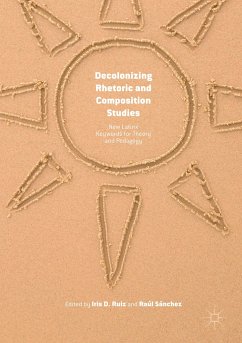
Gebundenes Buch
Behavioural Genetics for Education
Versandkostenfrei!
Versandfertig in 6-10 Tagen

PAYBACK Punkte
38 °P sammeln!





Educational environments interact with children's unique genetic profiles, leading to wide individual differences in learning ability, motivation, and achievement in different academic subjects - even when children study with the same teacher, attend the same school and follow the same curriculum. This book considers how education can benefit from the recent progress in genetically informative research. The book provides new insights into the origins of individual differences in education traits such as cognitive abilities and disabilities; motivation and personality; behavioural and emotional...
Educational environments interact with children's unique genetic profiles, leading to wide individual differences in learning ability, motivation, and achievement in different academic subjects - even when children study with the same teacher, attend the same school and follow the same curriculum. This book considers how education can benefit from the recent progress in genetically informative research. The book provides new insights into the origins of individual differences in education traits such as cognitive abilities and disabilities; motivation and personality; behavioural and emotional problems; social functioning; well-being, and academic achievement. Written and edited by international interdisciplinary experts, this book will be of interest to teachers, parents, educational and developmental psychologists, policy makers and researchers in different fields working on educationally-relevant issues.
Yulia Kovas is Professor of Genetics and Psychology at Goldsmiths, University of London, UK, where she directs InLab - International Laboratory for Interdisciplinary Investigations into Individual Differences in Learning. She is also the director of the Laboratory for Cognitive Investigations and Behavioural Genetics, Tomsk State University (TSU), Russia; co-director of the International Centre for Research in Human Development (TSU); and co-director of the Russian-British Laboratory for Behavioural Genetics, Psychological Institute of the Russian Academy of Education. She directs the Russian School Twin Register (RSTR) and leads the mathematics research direction in the Twins Early Development Study (TEDS), King's College, London, UK. Sergey Malykh is Professor of Psychological Institute of the Russian Academy of Education, where he directs the Laboratory for Developmental Behavioural Genetics and co-directs the Russian-British laboratory for Behavioural Genetics. He is also the Head (Academician-Secretary) of the Department of Psychology and Developmental Physiology of the Russian Academy of Education and co-director of the International Centre for Research in Human Development (TSU). The focus of his research is currently on the genetic and environmental origins of variation in psychological and psychophysiological traits. He is the author of more than 300 publications. Among them, Foundation of Behavioural Genetics (1998), the first textbook on this topic in Russia. Darya Gaysina is Lecturer in Psychology at the University of Sussex, UK and leads the interdisciplinary research program in Genetics and Psychopathology (EDGE Lab). She is also a member of the Rudd Centre for Adoption Research and Practice. Darya obtained a PhD in Human Genetics from the Russian Academy of Sciences. Her research focuses on exploring environmental and genetic factors, and their interplay, in relation to psychopathology across the life course. She is an author of more than 40 peer-reviewed papers and book chapters. Nicola L. Barclay, Northumbria Centre for Sleep Research, Northumbria University, UK Philipp Barsky' Psychological Institute, Russian Academy of Education, Russia Michel Boivin, École de psychologie, Pavillon Félix-Antoine-Savard, Université Laval, Canada Mara Brendgen, Département de psychologie, Faculté des sciences humaines, Université du Québec à Montréal, Canada Huajian Cai, Institute of Psychology, Chinese Academy of Sciences, China Sophia Docherty, MRC Social, Genetic & Development Psychiatry Centre, Institute of Psychiatry, Psychology and Neuroscience, King's College London, UK Darya Gaysina, Rudd Centre for Adoption Research and Practice, School of Psychology, University of Sussex, UK Elena Gindina, Psychological Institute,Russian Academy of Education, Russia Claire Haworth, University of Bristol, UK Jeffrey Henry, École de psychologie, Pavillon Félix-Antoine-Savard, Université Laval, Canada Philip Gehrman, Department of Psychiatry & Penn Sleep Centre, University of Pennsylvania, USA Alice M. Gregory, Department of Psychology, Goldsmiths, University of London, UK Ansatasia Kazantseva, Institute of Biochemistry and Genetics, Ufa Scientific Centre, Russian Academy of Sciences, Russia Elza Khusnutdinova, Institute of Biochemistry and Genetics, Ufa Scientific Centre, Russian Academy of Sciences, Russia; Bashkir State University, Russia Yulia Kovas, Tomsk State University, Russia; Psychological Institute, Russian Academy of Education, Russia; Goldsmiths, University of London, UK Yu L. L. Luo, Institute of Psychology, Chinese Academy of Sciences, China Sergey B.Malykh, Psychological Institute, Russian Academy of Education, Russia Rachael E. O'Leary, Department of Psychology, University of Kent, UK Michael J. Parsons, Mammalian Genetics Unit, MRC Harwell, UK Stephen A. Petrill, Department of Psychology, Ohio State University, USA Robert Plomin, MRC Social, Genetic & Development Psychiatry Centre, Institute of Psychiatry, Psychology and Neuroscience, King's College London, UK Kaili Rimfeld, Goldsmiths, University of London, UK Maja Rodic, Goldsmiths, University of London, UK Fatos Selita, Tomsk State University, Russia Tatiana Tikhomirova, Psychological Institute, Russian Academy of Education, Russia Maria Tosto' Department of Psychology, Goldsmiths College, University of London, UK Adelina Valiullina, Institute of Biochemistry and Genetics, Ufa Scientific Centre, Russian Academy of Sciences, Russia Aigul Zainullina, Institute of Biochemistry and Genetics, Ufa Scientific Centre, Russian Academy of Sciences, Russia
Produktdetails
- Verlag: Macmillan Education / Palgrave Macmillan UK / Springer Palgrave Macmillan
- Artikelnr. des Verlages: 978-1-137-43731-0
- Seitenzahl: 332
- Erscheinungstermin: 14. März 2016
- Englisch
- Abmessung: 222mm x 145mm x 23mm
- Gewicht: 545g
- ISBN-13: 9781137437310
- ISBN-10: 1137437316
- Artikelnr.: 44036155
Herstellerkennzeichnung
Springer-Verlag GmbH
Tiergartenstr. 17
69121 Heidelberg
ProductSafety@springernature.com
Review 1
The project proposes a book comprising 15 chapters that will be written by a variety of academics broadly in the fields of behaviour genetics and psychology. It is to be edited by three authors, Professor Sergey Malkyh, Dr Yulia Kovas and Dr Darya Gaysina. The book proposes to address how information from 'psychology, quantitative genetics, molecular genetics, neuroscience, and others' has 'implications... for understanding of complex educational processes'.
The proposal's strengths include contributions from some leading behaviour geneticists in the field. I can speak highly of one of the editors, Dr Yulia Kovas, who is a well-trained and informed behaviour geneticist. She has worked as a teacher in Russia and
The project proposes a book comprising 15 chapters that will be written by a variety of academics broadly in the fields of behaviour genetics and psychology. It is to be edited by three authors, Professor Sergey Malkyh, Dr Yulia Kovas and Dr Darya Gaysina. The book proposes to address how information from 'psychology, quantitative genetics, molecular genetics, neuroscience, and others' has 'implications... for understanding of complex educational processes'.
The proposal's strengths include contributions from some leading behaviour geneticists in the field. I can speak highly of one of the editors, Dr Yulia Kovas, who is a well-trained and informed behaviour geneticist. She has worked as a teacher in Russia and
Mehr anzeigen
has a broad and interesting portfolio of research relating to individual differences in learning and education. I do not know the other two editors. The authors of the chapters include a respected and highly cited behaviour geneticist with expertise in childhood sleep problems and related psychopathology (Dr Alice Gregory). Dr Claire Haworth, another rising star in behaviour genetics, is likely to write a chapter on the nature and nurture of wellbeing that will be of high quality and interest to fellow academics. As such, the book looks like it will be a very good quality book of edited chapters written by academic and suitable for an academic audience. The structure seems well thought out.
As the authors say, public and academic understanding of how to synthesise genetic findings with educational practices is naïve and requires many things, including more discussion of the issues raised, better understanding of the science, and public debate with policy-makers. I thought the authors could have provided a stronger argument in the 'Market Need' section. Nevertheless, this book will contribute to this important area.
In terms of the existing literature, a high profile lay book 'G is for Genes' has just been published . It received a huge amount of press coverage and deservedly so: it is written by one of the leaders in the field of behaviour genetics, Professor Robert Plomin, together with Dr Kathryn Asbury, who is a brilliant writer and excellent communicator of ideas in the fields of education and genetics. While the authors of the proposal suggest the two books will complement each other I remain unconvinced because the proposal is not convincingly selling a lay-person book.
In this vein, probably the key weakness of the proposal lies in the lack of clarity regarding the desired audience for the book. The authors seem confused on this point. On page two the editors write that 'this book will be of interest to teachers, parents, educational and developmental psychologists, and researchers in different fields'. In contrast, later in the proposal, in the Primary Market section, there is no mention of teachers and parents, but here suggestions jump around from researchers, practitioners, policy makers, undergraduates and postgraduates. This does not read like a 'primary market' but like a list of everyone the authors could potentially think would buy the book (but strangely no mention of the parents mentioned earlier on!). The titles of the chapters also give away a lack of thought about the audience, some being accessible for a lay audience ('How genetics can be helpful in education'), others being written for a specialist academic audience ('Negative psychological consequences of stress: The role of genetic risk and resilience factors').
A smaller point, but there were notable instances of rather awkwardly-phrased English (e.g. 'To date, no universal, effective for each child educational methods exist'). Once the authors have pinned down a clearer primary audience, I am sure they can improve the language.
To improve the book for publication, my recommendation is that the authors think hard who their primary market could be and then rethink the title and chapter headings to be aligned with
As the authors say, public and academic understanding of how to synthesise genetic findings with educational practices is naïve and requires many things, including more discussion of the issues raised, better understanding of the science, and public debate with policy-makers. I thought the authors could have provided a stronger argument in the 'Market Need' section. Nevertheless, this book will contribute to this important area.
In terms of the existing literature, a high profile lay book 'G is for Genes' has just been published . It received a huge amount of press coverage and deservedly so: it is written by one of the leaders in the field of behaviour genetics, Professor Robert Plomin, together with Dr Kathryn Asbury, who is a brilliant writer and excellent communicator of ideas in the fields of education and genetics. While the authors of the proposal suggest the two books will complement each other I remain unconvinced because the proposal is not convincingly selling a lay-person book.
In this vein, probably the key weakness of the proposal lies in the lack of clarity regarding the desired audience for the book. The authors seem confused on this point. On page two the editors write that 'this book will be of interest to teachers, parents, educational and developmental psychologists, and researchers in different fields'. In contrast, later in the proposal, in the Primary Market section, there is no mention of teachers and parents, but here suggestions jump around from researchers, practitioners, policy makers, undergraduates and postgraduates. This does not read like a 'primary market' but like a list of everyone the authors could potentially think would buy the book (but strangely no mention of the parents mentioned earlier on!). The titles of the chapters also give away a lack of thought about the audience, some being accessible for a lay audience ('How genetics can be helpful in education'), others being written for a specialist academic audience ('Negative psychological consequences of stress: The role of genetic risk and resilience factors').
A smaller point, but there were notable instances of rather awkwardly-phrased English (e.g. 'To date, no universal, effective for each child educational methods exist'). Once the authors have pinned down a clearer primary audience, I am sure they can improve the language.
To improve the book for publication, my recommendation is that the authors think hard who their primary market could be and then rethink the title and chapter headings to be aligned with
Schließen
Für dieses Produkt wurde noch keine Bewertung abgegeben. Wir würden uns sehr freuen, wenn du die erste Bewertung schreibst!
Eine Bewertung schreiben
Eine Bewertung schreiben
Andere Kunden interessierten sich für











